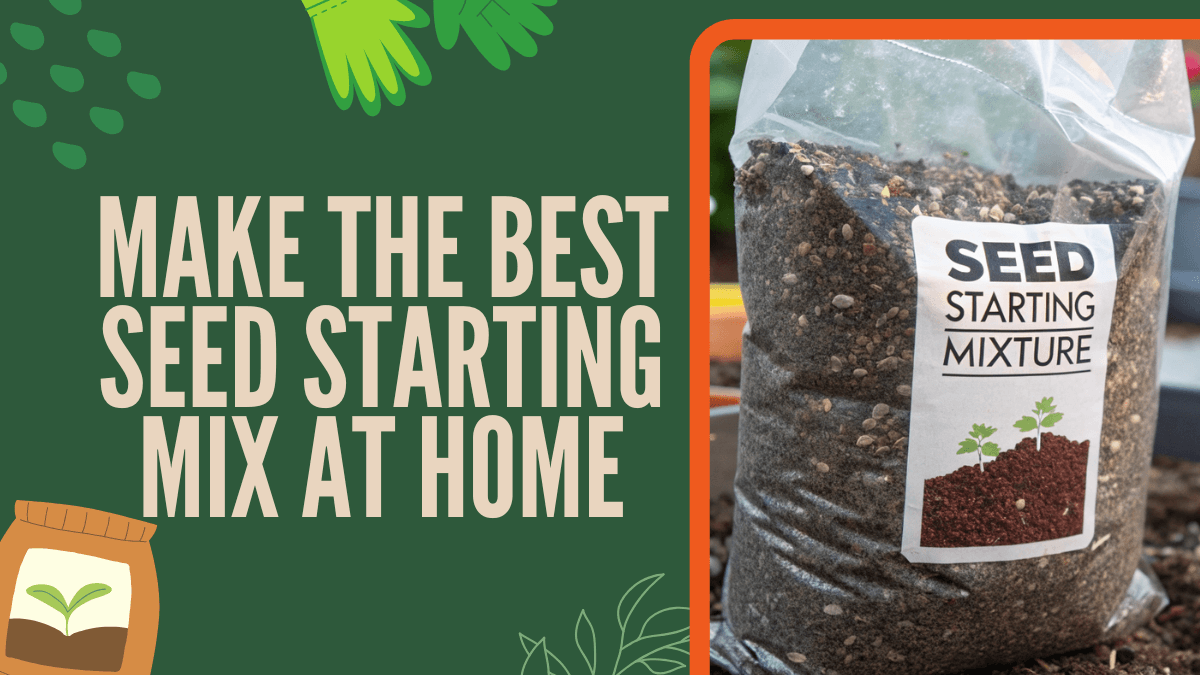Imagine planting a tiny seedling in heavy, clumpy soil—it’s like asking a baby to crawl through mud. Seedlings are fragile, and their first home (your seed starting mix) can make or break their growth. While grabbing a bag of commercial mix seems easy, many are overpriced, packed with synthetic additives, or contain peat moss, which harms the environment.
You can whip up a better, cheaper, and eco-friendly mix at home using simple ingredients. Let’s break down everything you need to know, from the science behind the mix to foolproof recipes and fixes for common problems.
Table of Contents
What Makes a Seed Starting Mix Work? (The Secret Sauce)
A great seed starting mix isn’t just dirt—it’s a carefully balanced environment. Here’s what your seedlings crave:
- Fluffy Texture: Roots need room to stretch! Heavy soils suffocate them.
- Moisture Control: The mix should hold water like a sponge but drain excess quickly.
- Zero Nasties: Sterile ingredients prevent mold, fungi, and pests.
- Gentle Nutrition: Seeds have their own food, but a light nutrient boost helps after sprouting.

Avoid garden soil—it’s too dense and might host weed seeds or diseases.
Bonus: Read my article “Can You Use Garden Soil in Pots?” to learn more about using garden soil in pots!
Your DIY Seed Starting Mix Recipe: Cheap, Easy, and Organic
Ready to play mad scientist? This recipe costs less than $2 per batch and takes 10 minutes.
Ingredients
- Coconut Coir (4 parts): A sustainable swap for peat moss. It’s pH-neutral, retains moisture, and comes in compact bricks.
Tip: Soak it in warm water first to fluff it up!
- Perlite (2 parts): Those little white balls aren’t just for looks—they keep the mix airy and prevent soggy roots.
- Compost (1 part): Use screened, sterilized compost (bake at 200°F {93°C} for 30 minutes) for a nutrient kick.
- Optional: A handful of vermiculite for extra moisture retention or coarse sand for drainage.

Step-by-Step Instructions
- Hydrate the Coir: Break off a chunk of coconut coir brick (one brick makes 8+ gallons!). Soak it in warm water until it expands into a crumbly, damp texture.
- Mix It Up: In a large tub, combine 4 parts coir, 2 parts perlite, and 1 part compost. Add sand or vermiculite if needed.
- Test the Mix: Grab a handful and squeeze. If it holds its shape briefly before crumbling, you’ve nailed it. Too wet? Add more perlite.
- Store Smart: Keep leftovers in a sealed container for up to 6 months.
Tailoring Your Mix to Different Plants
Not all plants are alike. Here’s how to tweak your mix:
- Tomatoes & Peppers: Add 1 tbsp of garden lime per gallon to balance acidity.
- Succulents & Herbs: Boost drainage with extra perlite or sand (3 parts coir, 2 parts perlite, 1 part sand).
- Flowers (Petunias, Marigolds): Mix in vermiculite to keep seeds moist during germination.
5 Costly Mistakes to Avoid (And How to Fix Them)
- Drowning Your Seedlings
Fix: Water only when the top ¼ inch of mix feels dry. Use a spray bottle for gentle hydration.
- Skipping Sterilization
Fix: Bake compost or reused mix at 180°F for 30 minutes to kill pathogens.
- Using Heavy Soil
Fix: Stick to lightweight coir and perlite—garden soil is a no-go.
- Overcrowding Seeds
Fix: Give seeds space! Crowded seedlings compete for light and nutrients.
- Ignoring Temperature
Fix: Most seeds need warmth (65–75°F) or (18-23°C). Use a heat mat for faster sprouting.
Troubleshooting Common Seedling Problems
- Mold on the Soil?
Sprinkle cinnamon (a natural antifungal), increase airflow with a fan, and ease up on watering.
- Leggy, Weak Seedlings?
Move grow lights closer (2–3 inches above plants) and keep them on for 14–16 hours daily.
- Yellow Leaves?
Could be overwatering or hunger. Let the mix dry slightly, then feed with diluted fish emulsion.
Best Store-Bought Seed Starting Mixes (For When DIY Isn’t an Option)
Short on time? These Amazon favorites deliver great results:
1. Back to the Roots Organic Seed Starting Mix

Back to the Roots
A balanced pH, which means it’s truly all-purpose
- Best For: Eco-conscious growers.
- Grab It If: Sustainability matters most.
2. Espoma Organic Seed Starter Mix

Espoma
A blend of endo & ecto mycorrhizae
- Best For: Delicate or finicky plants (e.g., herbs, flowers).
- Grab It If: You want premium quality without the DIY hassle.
3. Miracle-Gro Seed Starting Potting Mix

Miracle-Gro
Specially formulated for fast root development
- Best For: Beginners or budget gardeners.
- Grab It If: You’re growing veggies short-term or non-edibles.
Quick Comparison:
| Mix | Organic? | Best Feature |
|---|---|---|
| Miracle-Gro | No | Fast, affordable |
| Back to the Roots | Yes | Eco-friendly, peat-free |
| Espoma | Yes | Mycorrhizae for root power |
Why Peat Moss Isn’t Worth the Hype (And What to Use Instead)
Peat moss might be lightweight, but harvesting it destroys peat bogs—critical carbon sinks. Coconut coir, made from coconut husks, works just as well and is renewable. Swap peat for coir to keep your garden green in every sense!
Final Tips for Seed Starting Success
- Label Everything: Write plant names and dates on containers to track progress.
- Pre-Moisten Mix: Dry coir repels water—always hydrate before planting.
- Start Small: Test your mix with a few seeds before committing to a full tray.
Wrapping Up: Your Seedlings Deserve the Best
Whether you DIY your mix or opt for a trusted store-bought brand, the right foundation sets your seedlings up for success.
For under $2, you can create a custom mix that’s kinder to your plants—and the planet. Now, roll up your sleeves, get mixing, and watch those seeds soar!
Got questions? Drop them in the comments below—we’re here to help!


 ChatGPT
ChatGPT
 Perplexity
Perplexity
 Claude
Claude
Leave a Reply